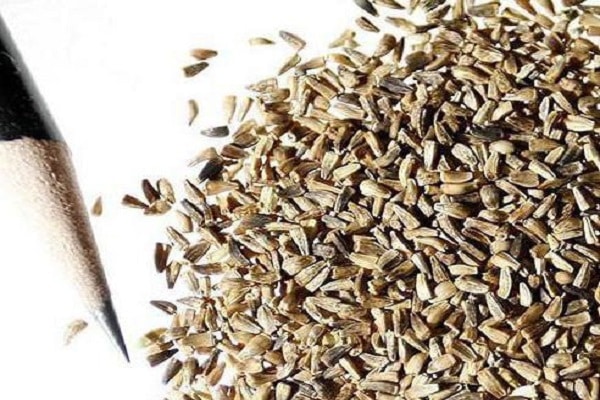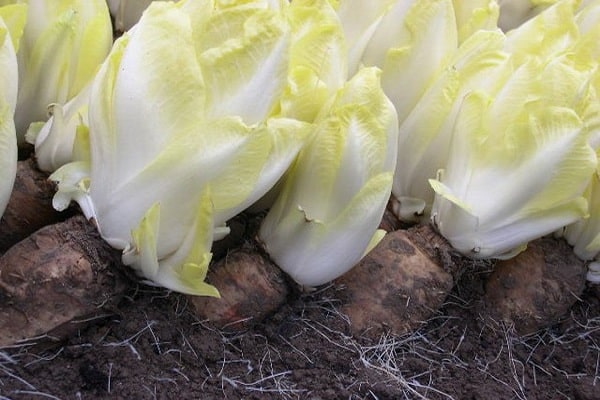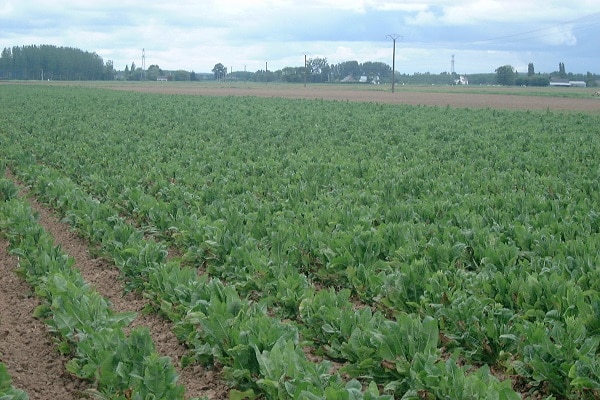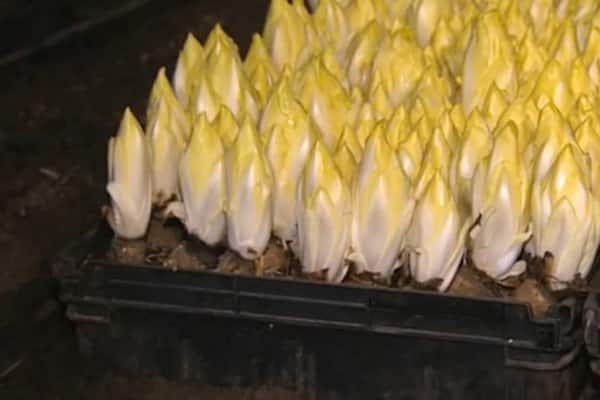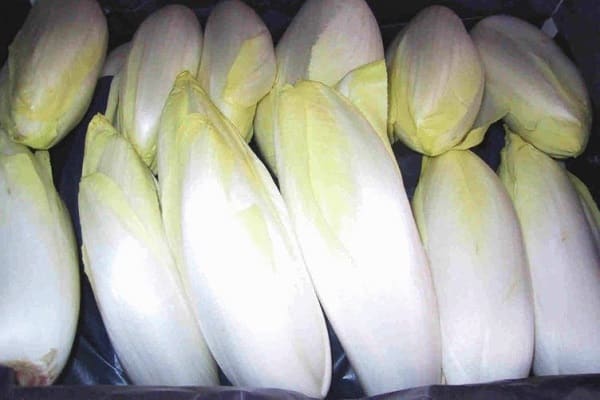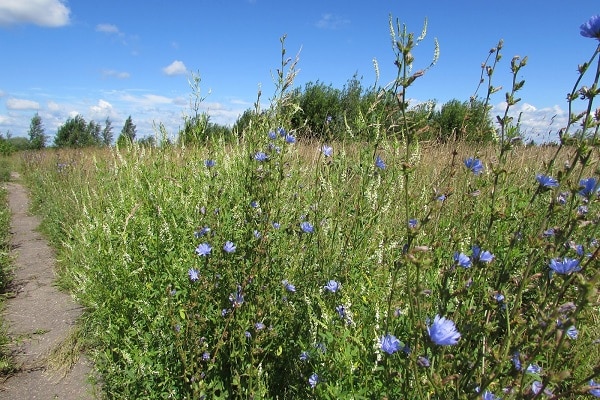Chicory is a plant with soft blue flowers that grows along roadsides and in fields. The culture is known for several reasons. Some people know the plant as a beautifully flowering herb, others like it as a piquant coffee substitute, and still others have paid attention to the medicinal properties of chicory. At the same time, you can not only purchase chicory at a pharmacy or store, but also start growing it in your garden without much effort.
- Characteristics
- Crop varieties
- What are the benefits of chicory?
- Plant propagation methods
- Timing for planting chicory
- Growing chicory seeds in open ground
- Seed preparation
- Preparing the landing site
- Sowing seeds
- Features of growing chicory at home
- How to replant chicory
- Rules for caring for crops
- Fertilizers
- Watering
- Protection from diseases and pests
- Weeding and loosening
- Harvesting
- How to prepare chicory flowers
- How to dry chicory herb
- How to harvest plant roots
- How to make coffee from your own chicory
Characteristics
The biennial culture is common in Europe, Russia, Central Asia, and Western Siberia. In the first year, a root system with root crops weighing up to 400 grams is formed. In the second year, chicory produces leaves and seeds.
A massive root, a long stem, up to 100-170 centimeters, with small fibers, leaves, blue flowers with a diameter of 3-5 centimeters distinguish the plant from others from the Asteraceae family. The oblong light brown fruits reach 3 millimeters.
The crop blooms from July until late autumn. Delicate flowers fade quickly and are replaced by new ones. The harvest can reach 20 thousand seeds.
Crop varieties
According to various sources, there are from 8 to 12 varieties of chicory. But only two types of plants are cultivated, such as:
- Salad. Young fresh leaves are used to prepare salads, side dishes, and meat treats. 3 varieties are popular:
- Escariole, Witloof - have succulent heads with wide leaves;
- Endive is similar in appearance to ordinary lettuce with curly carved leaves.
- Common variety. The culture is suitable for preparing medicinal drinks. The plant is planted as a decorative flower.
If you grow the plant as an alternative to coffee, it is better to take chicory root. The Yaroslavsky variety is popular on the territory of the Russian Federation, which received its name from the name of the region producing healthy grains for more than two hundred years.The plant, which actually came from Southern Europe, should be sown annually for greater yield.
What are the benefits of chicory?
Despite the powerful above-ground part, seeds and roots are used for medicinal and food purposes. The substance intibin gives the roots a specific bitter taste. Inulin makes the plant necessary for the diet menu of diabetics. In addition, the root system is rich in fructose, carotene, vitamins C, group B, and microelements: calcium, iron, magnesium, sodium. Healing decoctions are made from the lower part of the plant.
Chicory is used in medicine as a means of treating diseases of the skin, kidneys, spleen of the kidneys, and inflammation of the eyes.
The beans are of great importance as a substitute for a coffee drink. The infusion helps remove gallstones, improves blood circulation, and has a restorative effect. During the day, chicory will invigorate, toning, calming the nervous system, and at night it will relieve insomnia.
A document dating back to the 4th millennium BC was found in Ancient Egypt, confirming information about chicory as a remedy for diseases of the stomach, liver, and intestines.
Plant propagation methods
The plant reproduces in two ways at once: seed, root. The roots are divided into parts, each of which is the basis of a new bush.
Chicory is called a clock plant. On a bright morning the flower opens, but with the onset of cloudy weather or evening the flowers close instantly. The culture is a good honey plant, blooms for up to 3 months, giving a lot of pollen and nectar.
To prepare seeds, you need to “pack” the flower stalks with gauze caps, paper envelopes or bags for 21 days after flowering. At the beginning of the harvest period, cut off the inflorescences with the stem and hang them in a warm, ventilated room to ripen.As a result, the seeds will fall into the prepared containers.
Timing for planting chicory
Medicinal species are planted in early spring, as soon as the soil thaws. It is better to plant salad varieties no earlier than mid-May. There is no need to sow seeds before winter, as many flowering plants will appear.
Low air temperatures will provoke early flowering of the crop, and the root system will not form.
Growing chicory seeds in open ground
Even a novice gardener can grow chicory in the country, because the process is similar to growing any vegetable crop. The plant withstands temperature changes, hot days in the garden, short-term frosts, and cold temperatures up to 10 degrees below zero.
Seed preparation
Before planting, lettuce seeds should be germinated in damp cotton material or a napkin. To speed up the process, place the bundle on a warm radiator and leave for 2-3 days. Constantly check that the fabric is warm and damp. If necessary, sprinkle the seed sac with warm water.
You can soak chicory in a special stimulant for 5-6 hours to increase yield.
Plant seeds of the ordinary variety immediately, without pre-soaking.
Preparing the landing site
Before planting, you need to prepare both the seeds and the soil itself:
- The area is dug up in advance, leveled, and moistened abundantly. If necessary, the area is fertilized.
- The soil for the plant is not acidic, loamy. Acidic soil is limed in advance.
- The area should be illuminated and not cluttered with trees. The flower loves direct sunlight, as bright as possible.
- It is advisable to prepare the site for sowing in bulk using humus fertilizers and peat. The dug up area is fertilized with a mineral solution at the rate of 3 tablespoons per 1 meter of area.Peat fertilizers with humus and nitrophos are mixed with the soil and leveled, making the soil loose.
- After this, fill the area with water.
- Next, grooves are made at a distance of 30-35 centimeters from each other, where varieties of chicory are planted - both salad and ordinary.
Also, when planting, it is important to take into account that the strong coffee aroma attracts pests. Therefore, the location should be chosen as far as possible from valuable crops.
It is ideal to grow chicory at the back of combined flower beds, multi-row flower beds - mixborders. It is better to combine flowers with annual crops, since the overall picture is not lost when the root is removed. Pale blue flowers with violets, cornflowers, and daisies look beautiful. Spicy herbs such as basil, dill or parsley are the most suitable neighbors.
In Ancient Egypt, chicory was used as an antidote for the bite of poisonous snakes and insects. Based on chicory, people prepared healing infusions for indigestion and eye inflammation.
Sowing seeds
Seeds should be planted to a depth of no more than 1-1.5 centimeters. The distance between seedlings is at least 8 centimeters. It is important to maintain the proportions of the row spacing, leaving a distance of up to 40-60 centimeters per adult plant.
Deep planting of seeds will reduce both the germination rate of the plant and the germination time.
The first shoots will be visible on days 7-14. As it grows and develops, it is necessary to thin out the crop. Otherwise, young plants will destroy each other (the minimum distance between adult specimens is 30 centimeters).
Features of growing chicory at home
You can grow the salad variety both in your summer cottage, garden, and on the windowsill of your apartment. For home growing:
- At the end of September, lettuce leaves along with roots are removed from the beds.The harvest is stored and left for several days to dry and dry.
- Then the greens are cut off, and the root system, without clearing the soil, is put away for storage (at a temperature of +1*+2 degrees).
- Rhizomes with an uncut head and buds cut at a height of 10 millimeters are planted in a box for the winter.
- The soil chosen is sandy loam or a mixture of peat and sand. The soil layer should reach 40 centimeters in height.
- Root crops are planted 25-30 days before harvest. Place the roots to a depth of at least 15-20 centimeters.
- For greater yield, the substrate is constantly moistened with water at room temperature. The air temperature is maintained at 16-18 degrees.
- Cut off the heads of cabbage with part of the rhizome so that the leaves do not crumble. The fruits are stored for 2-3 weeks in the refrigerator, used in salads and to decorate dishes.
You can grow the salad variety in plastic pots:
- Root crops are placed so that the heads are 1-1.5 centimeters above the ground level.
- The soil is moistened abundantly.
- Cover the pot with black polyethylene and put it away for 10-12 days in a room with a temperature of 13-14 degrees.
- The plant spends the next 12-24 days in a room with a higher temperature - 16-18 degrees. The entire growth period will take 22-24 days. During this time, the heads of cabbage will grow to 150-180 grams each. Since root vegetables are deprived of light, the heads of cabbage will have a white color.
How to replant chicory
When chicory has 3 leaves, it is advisable to thin out the crop, throwing away excess specimens. The plant cannot be transplanted.
Rules for caring for crops
Caring for chicory is very simple, like any other plant of the Asteraceae family.All care comes down to thinning the plants (with an interval of 8-15 centimeters), weeding, loosening, proper moderate watering, fertilizing the soil, and protecting the plant from pests.
Fertilizers
Feed chicory with mineral fertilizers at the rate of 1 gram per 1 meter. For feeding, both wood ash and compost and humus are used. In moderate quantities, the soil is flavored with superphosphate, potassium salt and ammonium nitrate solution.
The crop is fed at intervals of 14-21 days, alternating mineral and organic fertilizers.
Watering
Despite the fact that chicory tolerates both heat and cold well, for a sufficient harvest it is necessary to carry out proper moderate watering:
- Do not overwater the plant, otherwise the leaves will rot.
- You can conserve moisture by mulching.
- On hot days it is permissible to spray the leaves.
- In winter, do not moisten the plant.
Ideal soil humidity is 75%, air humidity is 80%.
The watering schedule also depends on the amount of precipitation, air temperature and plant variety. The salad species does not tolerate long-term drought and needs constant soil moisture. The medicinal variety is more resistant to heat and requires watering only in the absence of rain for a long time.
Protection from diseases and pests
Ordinary chicory is resistant to various diseases and pests. Salad varieties of chicory are more susceptible to diseases such as leaf spot and rot.
Pests include slugs, leaf aphids, root mites and wireworms. The slugs are removed by hand, and the ground around the chicory is sprinkled with crushed egg shells or sand.
For prevention, it is necessary to promptly remove weeds, destroy plants with rot, and water the crop moderately.All these activities contribute to the growth and flowering of chicory.
Weeding and loosening
The plant also needs to be protected from weeds and constant access of oxygen to the roots. For this purpose, the soil is constantly weeded and loosened.
Harvesting
Medicinal chicory blooms only in the second year after planting, as it is a biennial plant. In the first year, roots are collected. The leaves are cut off in late autumn, leaving the crop in a “naked” form for wintering.
Salad chicory is harvested in October. The heads of cabbage are cut with a sharp knife. Store lettuce leaves in the refrigerator or cellar.
How to prepare chicory flowers
Preparing chicory flowers in the following way:
- The flowers are harvested during their abundant bloom, from June to September.
- Choose plants away from highways and roadways.
- The weather for collection should be dry and warm.
- Do not collect flowers early in the morning, as the dew has not yet dried.
- Cut off only the delicate flowers without the stem part for drying.
How to dry chicory herb
Dry the cut stems of the plant in the shade, under a canopy. Spread the raw materials in one layer on a cloth and dry in the attic.
Stir the drying periodically to ensure uniform drying. As soon as the stems begin to break, the raw material is ready.
How to harvest plant roots
In early spring or late autumn, after the above-ground part dies, roots begin to be harvested. The root system is saturated with minerals as it prepares for winter.
Prepare the roots as follows:
- Dig up the roots of the plant.
- The rhizomes are cleared of soil and washed. Thin lateral roots are removed.
- Initially, the roots are dried.
- The rhizomes are cut lengthwise into small plates; large ones are cut crosswise.
- Dry the workpieces using a dryer, oven, at a temperature of 60 degrees, in a ventilated room.
The harvest is stored for no more than 3 years in cardboard boxes, wooden boxes or paper bags.
How to make coffee from your own chicory
It is very easy to prepare a coffee substitute from the harvested crop. For this:
- Cut the roots into cubes 1-1.5 centimeters thick.
- Dry the crop using drying at a heating temperature of 100 degrees for 12 hours.
- Fry the preparations in a frying pan, cool.
- Grind the roots with a blender, coffee grinder, or mortar.
- Use as a natural drink at the rate of 1 teaspoon per glass of boiling water.
For aroma, mix chicory with barley, rowan, oats, rye, almond or acorn kernels.







